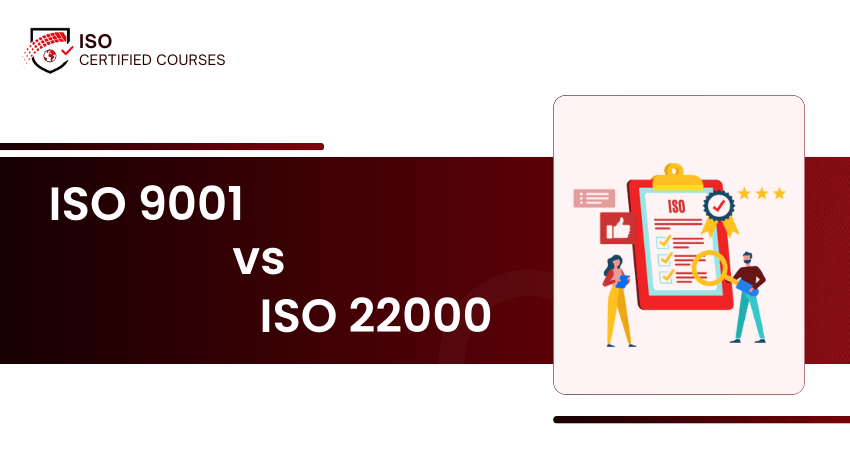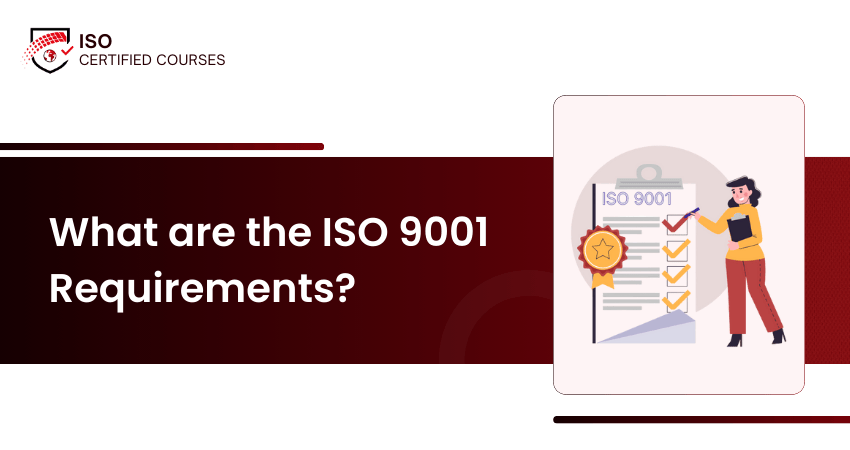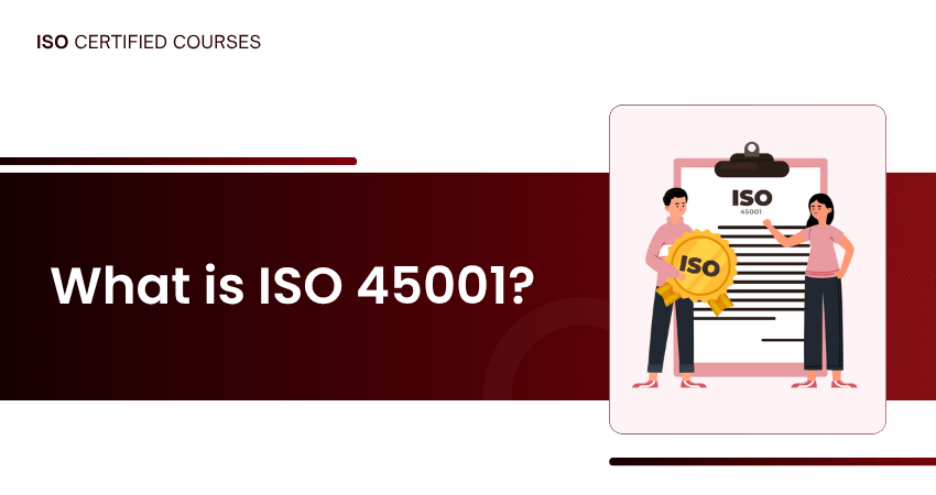
Imagine stepping into a workplace where safety isn't just a rule; it's part of the culture. ISO 45001 makes this possible by guiding organisations to create safer, healthier environments through a clear and practical system. It helps reduce risks, prevent accidents, and improve well-being across all levels. It encourages active involvement, clear responsibilities, and stronger safety leadership. Whether you're a business leader or safety manager, understanding this standard is key. In this blog, we’ll uncover What is ISO 45001, how it works and its structure.
Table of Contents
1) What is ISO 45001?
2) Major Benefits of ISO 45001
3) Why was ISO 45001 Created?
4) The ISO 45001 Certification Process
5) Key Clauses and Structure of ISO 45001
6) Conclusion
What is ISO 45001?
ISO 45001 is an international standard for Occupational Health and Safety (OH&S) Management Systems. It helps organisations create safer workplaces by reducing risks, preventing accidents, and improving worker well-being. Any business, large or small, can use this standard to protect employees and improve safety.
For example, a construction company may use ISO 45001 to reduce the risk of falls at building sites. They assess the dangers, provide safety gear, and train workers on proper procedures. As a result, accidents decrease, staff feel safer, and projects run more smoothly. This shows how ISO 45001 can make a real difference.

Major Benefits of ISO 45001
ISO 45001 brings clear advantages to organisations by improving workplace safety, meeting legal requirements, and supporting employee well-being. Let us explore how this standard can make a meaningful difference to your organisation:
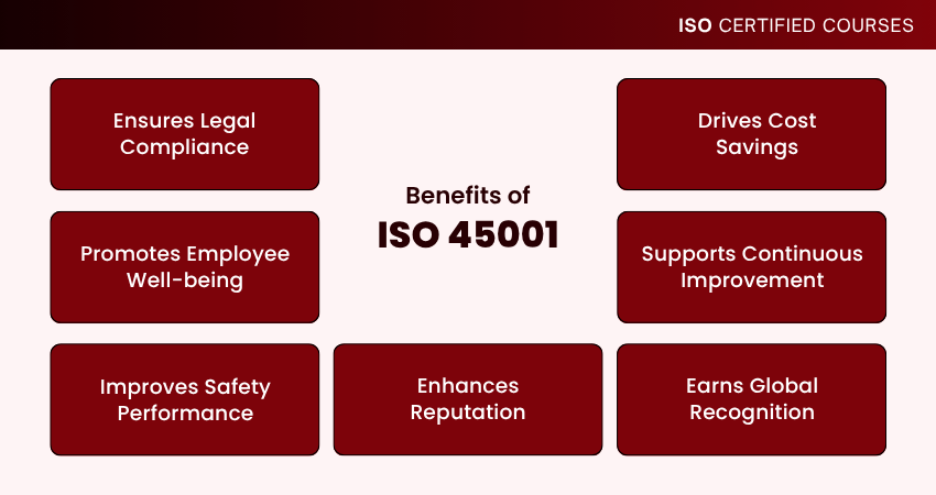
1) Ensures Legal Compliance
ISO 45001 helps organisations meet both local and international Occupational Health and Safety (OH&S) laws. It reduces the risk of legal penalties by ensuring all legal obligations are fulfilled. The system encourages regular monitoring and documentation to stay legally aligned.
2) Promotes Employee Well-being
The standard supports both physical and mental health by focusing on hazard prevention and safer work conditions. It creates a positive, healthy work culture where employees feel valued and motivated. ISO 45001 helps limit harmful exposure and improve daily working environments.
3) Improves Safety Performance
Organisations using ISO 45001 can reduce workplace injuries and illnesses by identifying risks early. It encourages effective safety practices and ongoing risk control. This leads to a safer, more productive, and stable workforce.
4) Enhances Reputation
Having a certified OH&S system shows a strong commitment to employee welfare and responsible operations. It builds trust with clients, employees, and stakeholders while strengthening your organisation’s reputation and credibility in the market.
5) Drives Cost Savings
Workplace incidents can lead to high compensation claims, legal costs, and insurance premiums. ISO 45001 reduces these risks through better safety practices. Fewer accidents mean less downtime and higher overall productivity.
6) Supports Continuous Improvement
Based on the Plan-Do-Check-Act model, ISO 45001 encourages ongoing review and updates to safety procedures. This keeps your OH&S system effective, adaptable, and aligned with changing needs over time.
7) Earns Global Recognition
ISO 45001 is a globally recognised standard that shows your organisation’s commitment to safety. It enhances credibility across global markets and opens opportunities for international business partnerships.
Lead audits and build a resilient safety culture with our ISO 45001 Lead Implementer Course – Join now!
Why was ISO 45001 Created?
ISO 45001 was developed to help organisations better manage health and safety risks. Despite existing measures, work-related injuries, illnesses, and deaths remain high. According to the International Labour Organization (ILO), 2.78 million people die each year due to work-related causes, with another 374 million suffering non-fatal injuries annually.
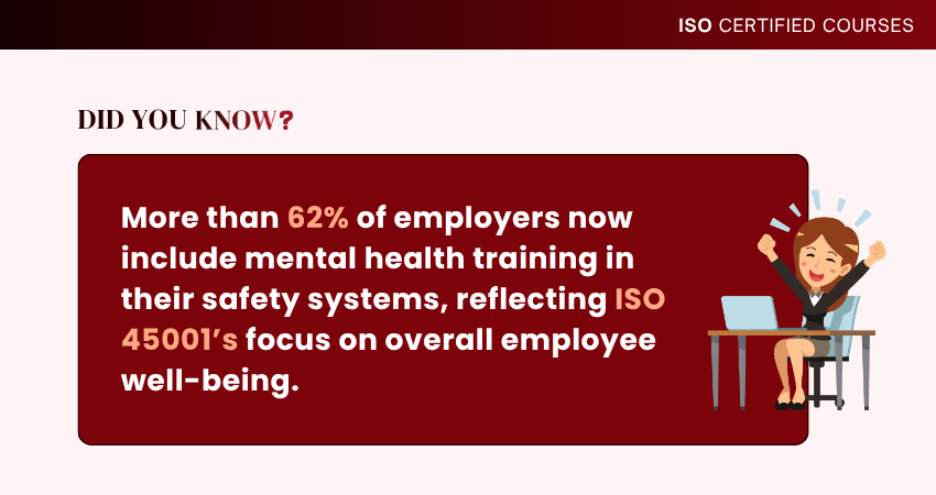
These alarming figures show the urgent need for a global standard. David Smith, the Chairperson of the ISO 45001 Development Committee, stated that ISO 45001 aims to transform workplace safety and reduce the tragic toll of accidents and illnesses. Developed with input from over 70 countries, it became the first truly international standard for Occupational Health and Safety.
The ISO 45001 Certification Process
Gaining ISO 45001 Certification involves aligning your organisation’s health and safety practices with the requirements of the standard. Here’s how the certification journey unfolds, from preparation to achieving and maintaining certification:
1) Initial Gap Analysis: Review your current health and safety practices to identify gaps compared to ISO 45001 requirements.
2) Planning and System Development: Develop an Occupational Health and Safety Management System (OH&S MS), including policies, objectives, and procedures aligned with ISO 45001.
3) Implementation: Put the system into action across the organisation. Train employees, manage documentation, and promote active worker participation.
4) Internal Audit: Conduct an internal audit to evaluate whether the system is being followed and is effective.
5) Management Review: Top management reviews the system’s performance and ensures it supports strategic goals.
6) Corrective Actions: Address any nonconformities found during internal audits and make improvements where needed.
7) Stage 1 Audit (Documentation Review): A third-party auditor checks your documented system to ensure it meets ISO 45001 requirements.
8) Stage 2 Audit (On-Site Assessment): The auditor visits your workplace to verify that the system is properly implemented and effective.
9) Certification Decision: If both audit stages are successful, your organisation is awarded ISO 45001 certification.
10) Ongoing Surveillance Audits: Regular audits (usually annually) ensure the system is maintained and continues to improve.
11) Recertification (Every 3 Years): A full reassessment is conducted every three years to renew the certification.
Strengthen internal controls and identify risks with our ISO 45001 Internal Auditor – Register today!
Key Clauses and Structure of ISO 45001
Let us break down these ten clauses to understand how each contributes to building a strong Occupational Health and Safety (OH&S) Management System:
1) Scope (Clause 1): The intent of ISO 45001 is to assist organisations in preventing work-related ill-health and injury and to provide a safe and healthy workplace.
2) References (Clause 2): Identifies all publications and other documents cited in the standard. There are no normative references IN iso 45001.
3) Terms and Definitions (Clause 3): Defines important verification terms used in the standard, including risk, worker and incident.
4) Context of the Organisation (Clause 4): Enables the organisation to identify internal and external issues. It determines who their interested parties are and the extent of their OH&S system.
5) Leadership and Worker Participation (Clauses 5): Requires leadership commitment, accountability and active participation of workers in the OH&S system.
6) Planning (Clause 6): Includes risk and opportunity-based thinking, legal and other requirements. It is a start to the planning of OH&S goals.
7) Support (Clause 7): Specifies the potential support resources, competence, awareness, communication and documented information required for effective application.
8) Operation (Clause 8): This is the realisation or deployment of OH&S controls. It covers change management, procurement and emergency preparedness and response.
9) Performance Evaluation (Clause 9): It requires monitoring, measurement, analysis, internal audits and management review in order to determine whether the OH&S system is effective or not.
10) Improvement (Clause 10): Promotes resolving conformities and taking corrective action. It promotes ongoing enhancement of OH&S performance.
Conclusion
We hope this blog has helped you understand What is ISO 45001 and why it matters. By following this international standard, organisations can tackle the critical challenge of workplace health and safety. It offers a clear path to building proactive systems that protect employees and meet legal requirements. Through effective implementation, businesses can strengthen their safety culture, reduce risks, and create a more resilient organisation ready for long-term success.
Advance your role in safety, reduce incidents, and gain industry recognition with our ISO 45001 Certification – Join now!
Search Smarter
Quickly search through our blog content for what interests you
No match found


































